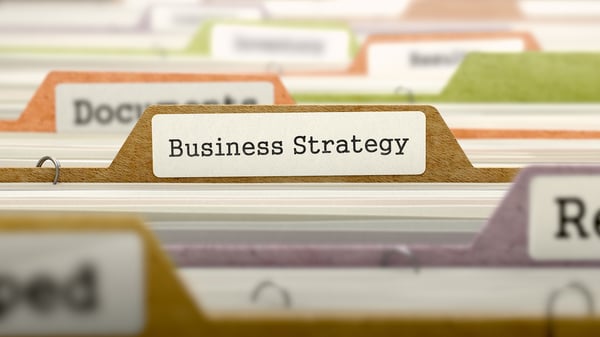Are you creating content to market your product, but haven’t seen an increase in traffic? It’s not as simple as writing blog posts or graphics and throwing them into the internet void. You have to have a plan. A roadmap. A long-term strategy for all your content. It’s like the old saying goes - if you fail to plan, you plan to fail!
Hopefully, you’ve taken time to familiarize yourself on the basics of inbound marketing and built foundational cornerstones like creating buyer personas. Those are important steps not to be overlooked! The next important step to take is planning out your long-term content strategy. The best tool to do this is by using the content compass.

What is a Content Compass?
A content compass is a spreadsheet you can use to help organize and plan your content strategy. They can take many forms - a handwritten worksheet, a gridded printout, or a spreadsheet in Excel or Google Sheets.
Imagine creating a bird’s eye view of a plan covering a 12-month period. You have each month of the year, with different columns for you to add in an overall content theme and different types of content you’ll be planning for that specific month. That’s the basic overview of what a content compass looks like.
What Information Do I Include?
A content compass needs different columns to write in details. Start by creating a column outlining each month of the year in a different row. Now you have your time structure in place. Next, you’ll want to create columns from left to right with the following headers:
1. S.M.A.R.T. Goals
These are measurable objectives to know how effective your marketing campaigns are. Each letter stands for a different principle when setting a goal.
S - Specific (State what you’ll do and use action words)
M - Measurable (Provide a clear way to evaluate the goal and use specific metrics or data targets)
A - Actionable (Make it achievable - within the scope of possibility)
R - Relevant (Make sure the goal fits the skillset of the person it’s being assigned to and improves the organization in some way)
T - Time-bound (State a specific deadline & set a hard timeline to work towards a goal)
An example of a completed S.M.A.R.T. goal would be:
“Increase website visits in the 3rd quarter by 15% from 1,000 to 1,150”
2. Campaign Theme
Your content should all work towards a unifying goal, and the best way to ensure this is by setting an overarching campaign focus for each month/set of months.
Say you’re a private school who wants to reach out to the homeschool community. Your campaign theme would be “Homeschoolers” and all content created for within the campaign would focus on attracting this group.
3. Keywords
When creating ideas for blog posts (which are incredibly important for ranking on search engines) it’s worth taking time to research keywords already being used. When crafting topics to write about, make sure people are actually searching for these issues.
If you run a pet grooming service, knowing potential customers are searching for “pet shampooing tips” or “how to clip my cat’s nails” now gives you two topics to help people start solving their issues and start discovering how you can help them! While there are numerous keyword research services out there, start with the free, quality ones like Google Ads or Ubersuggest by Neil Patel.
4. Campaign Offers
A key tactic in moving people along the buyer’s journey (or down the sales funnel) is by creating opportunities to explore your product more deeply. While someone may have visited your site to check out a blog post, they need another prompt to learn more. Offering special offers is the perfect engagement method. Campaign offers could be downloadable ebooks, an email newsletter signup, or a free 30-day trial to try your service. Think about ways you can get website visitors to spend more time with you!
5. Workshops/External Events
Having a strong content game is vital to business success, but you need to offer opportunities for face-to-face contact as well. Now, this doesn’t mean these opportunities need to be in person every time, but people still crave that opportunity to connect on a conversational level.
Hosting workshops or external events are the perfect way to accomplish this objective. If you’re a interior designer, offer a workshop on using color palettes for designing entryways using a group video meeting service like Skype or Zoom. Offer an external event sampling your products at a hotel conference room if you own a bakery. Build the chance to meet and connect with your audience, and your relationship will grow!
6. Email Newsletter
An email newsletter is one of the most desirable ways keep in touch with both potential and returning customers. Once you have an email address, you have a direct line to an individual’s inbox, with no marketing or advertising needed. In order to get subscribers to open and engage with your newsletter content, take time to plan what articles and offers you’ll include in each issue. And make sure they tie back to your campaign theme!
7. Social Media
If you’re not using social media to attract an audience, you’re missing out on a powerful marketing vehicle! Facebook, Instagram, Twitter, and LinkedIn are all excellent options to consider when sharing content you’ve created with the worldwide community. Plan out how often you’ll post, and use the campaign theme to direct what you’ll be posting.
How to Use the Content Compass
When filling out your compass, It’s best to plan out in 90-day blocks for content. You can fill out more, but business goals can change quickly, so keep a flexible attitude when it comes to adjusting your content strategy.
You don’t need to fill out every column for every campaign; sometimes a workshop just doesn’t fit in the plans - and that’s okay! As a rule of thumb, always try and have your blog posts, campaign offers, and social media columns filled out for each month. Those are the most important!
Next Steps
If you need a template to get started, Rizen has a downloadable content compass template in Google Sheets or Microsoft Excel that includes a content audit worksheet an external event planner. All you need to do is sign up for our email newsletter. You’ll receive a new issue just once a month. We don’t believe in inbox clutter.
Each email is filled with other great inbound tips and tricks for your growing business. If you’d like to hear more about long-term content strategy and using a content compass, check out our Inbound Academy podcast.
So what are you waiting for? Claim your complimentary templates and connect with Rizen today!
You can learn more about reaching today's customers by reading our web guide on the basics of Inbound Marketing.



![Reignite Your Millennial Marketing Efforts With These [On Fleek] Ideas](https://blog.gorizen.com/hs-fs/hubfs/Podcast/009%20-%20Millennial%20Marketing%20Blog.gif?length=600&name=009%20-%20Millennial%20Marketing%20Blog.gif)


No Comments Yet
Let us know what you think